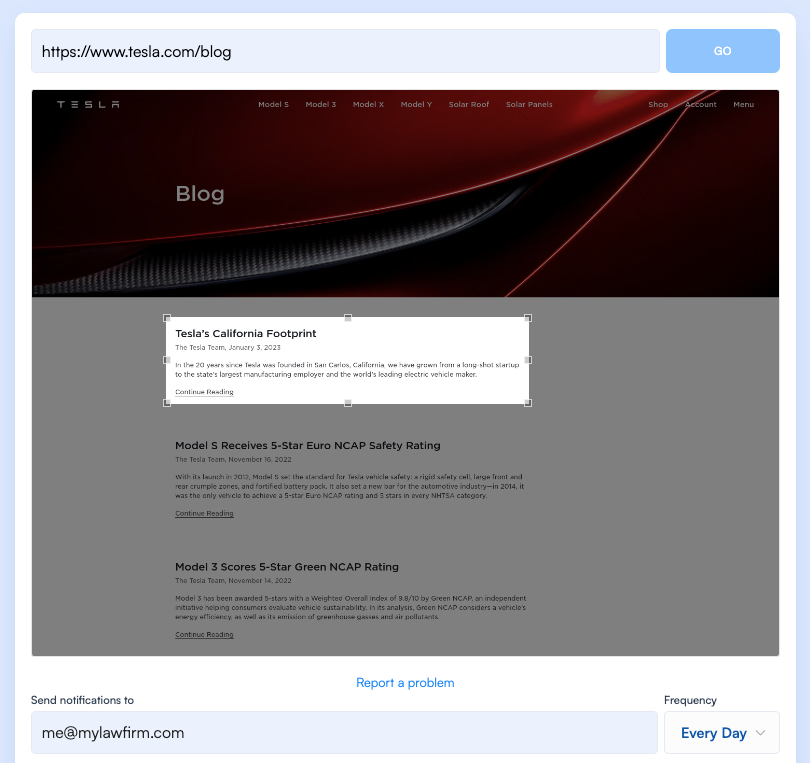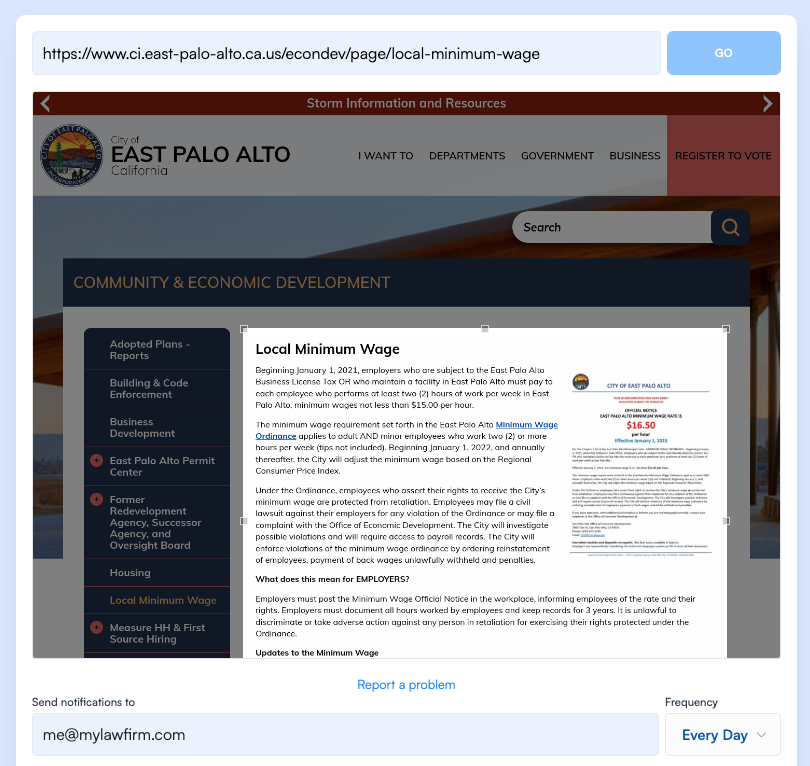8 Things Law Firms Should Be Monitoring to Add Value to Client Relationships
By Emily Fenton
Updated January 3, 2023

As a law firm that works with corporate clients big or small, you should always be looking for new ways to add value to your client relationships.
Seeking out new opportunities to go above and beyond is guaranteed to strengthen your relationships and increase client satisfaction. This will lead to all kinds of positive outcomes for your firm; including new projects and engagements, increased client loyalty, and more new business from word-of-mouth referrals.
But that’s not all: by embracing systemized and creative approaches to generating insights for your clients, you can increase your law firm’s differentiation and ability to serve different niches - all while reducing the costs that go into staying on top of the things your clients care about.
Use Visualping, an AI legal research tool, to automate the monitoring of these information sources to get proactive ideas for new engagements and service existing cases more effectively. Visualping is the leading world’s website change detection tool, already used by 98% of the Am Law 100 to monitor for regulatory intelligence, non-compliance, and much more.
How to Add Value to Client Relationships by Monitoring the Web with Visualping
1. Watch for compliance issues on your client’s website
Consider monitoring the privacy policy, disclaimer, or contract language that appears on your clients’ websites. Whenever this language changes, a quick review can reveal changes that were made without your consultation.

2. Monitor executive team updates
When a new executive joins or leaves your client’s company, it is unlikely that the client will think to inform you of this change. But depending on the executive, this personnel change could either put existing engagements in jeopardy or create an opportunity for a new one.
Your law firm business development team should be monitoring the leadership pages of key clients so that they can react in a timely manner to these changes.

3. Keep an eye on press and news content
Watching the news concerning your clients is an easy way to ensure you’re staying abreast of their latest developments; whether these are directly related to legal issues or not. Monitor news sites, as well as specific legal sources and the client’s own press content to stay in the loop with your client’s latest moves and concerns.

4. Track specific legal updates
When you operate in specific legal niches, your clients may expect that you are keeping them informed of relevant changes to the laws that impact their operations. This generally involves monitoring web pages from a certain government agency or body.
For example, you may have an employment law practice at your firm. You can use Visualping to monitor changes to local minimum wage laws and work with your clients to ensure they are compliant with these regulations.

5. Get notified about court and case updates
The courts are constantly publishing orders, case status updates, and procedural instructions that impact your clients. Whether for a specific case or important legal process, you can use Visualping to get the updates you need.
Let’s say you regularly file a specific motion in a specific court on the behalf of a client. Monitoring that court form for changes is a good way to ensure you’re not caught unawares when the format changes.

6. Spy on your client’s competitors
So far, we’ve advised watching for developments that are directly related to your own clients. But watching your clients’ competitors for legal maneuvers can yield excellent insights and opportunities. We suggest monitoring pages such as the terms of service on your clients’ competitors' websites for changes so you might advise your client to make a similar change.
You should also monitor court and government agency websites for any ongoing legal processes or decisions related to your clients’ competitors' operations to ensure that your clients are preparing for - or are steering clear of - similar issues.
7. Look out for potentially fraudulent domains
Online fraud and impersonation is everywhere. One unsavory tactic is to register domain "lookalikes" to use in phishing emails. These situations require legal action such as a cease-and-desist letter.
If lookalikes or copyright infringement is an ongoing concern for your clients, we suggest monitoring known or potential lookalikes for changes, so you can get alerted when a bad actor may have taken over a domain with the intent to impersonate your client.
Let’s say your client is Netflix. You should monitor a domain like nefflix.com (note the spelling error), so you can ensure that this domain is not used for any purpose that could seriously harm the Netflix brand.

8. Monitor adverse parties
As with your clients’ competitors, you should consider monitoring the opposing side of any lawsuit you are engaged in. This could include monitoring social media profiles, websites, or any of the other sources mentioned above for intel that could give you an edge in your proceedings.
How to use Visualping to monitor the web
Did any of these ideas catch your eye? Getting started with Visualping to automatically monitor these pages is easy. Just tell our tool which URL you want to monitor, select the area of the page you care about, and we'll check it periodically and send you an email with any changes.
Step 1: Copy and Paste the Page URL You Want to Track into the Search Bar on Visualping’s Homepage
To begin, simply go to Visualping's homepage, and copy and paste the URL from the web source you want into the search engine.
Step 2: Select the Part of the Page You Want to Monitor
Next, select the specific area of the page that’ll update with the changes you care about. Or, you can just monitor the whole page for changes – it’s up to you.
Step 3: Choose How Often You Want Visualping to Check the Page for Changes
To set how often Visualping checks the page, select your frequency of checks. Depending on the urgency of your subject matter, Visualping can check a page anywhere from every 5 minutes, to once a month.
Step 4: Enter the Email Address You Want to Use to Receive Updates
Visualping needs an email address to send alerts to.
You can easily change it later from your Visualping account page, but you need to enter an email address at this point in the sign up process, in order to activate your account.
You’re almost done!
Step 5: Check Your Email, Make a Password, and You’re Done
Once you’ve entered your email, you’ll get a message in your inbox from Visualping asking you to set your password.
After you’ve completed these steps, you can easily view all of your tracked pages in a single place, in your user dashboard.
Visualping for Business
When you sign up for a Visualping for Business account, you’ll get access to bulk upload features (to prevent you from entering every web page one-at-a-time), and dedicated support to help you set up all the pages exactly how you need them. Be sure to reach out to our team if you have any questions!
Get the latest legal knowledge
Sign up with Visualping for automatic legal and regulatory alerts, from any sources online.
Emily Fenton
Emily is the Product Marketing Manager at Visualping. She has a degree in English Literature and a Masters in Management. When she’s not researching and writing about all things Visualping, she loves exploring new restaurants, playing guitar and petting her cats